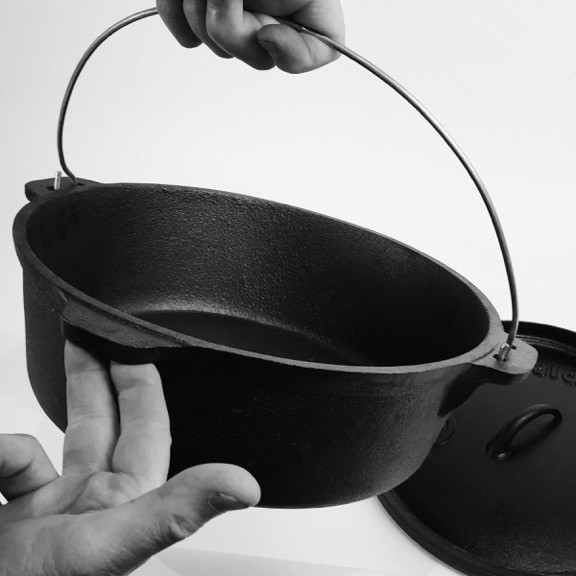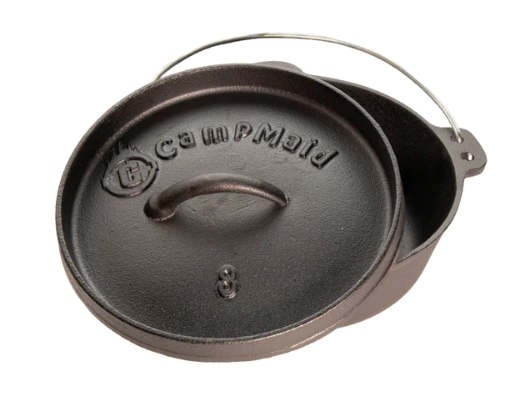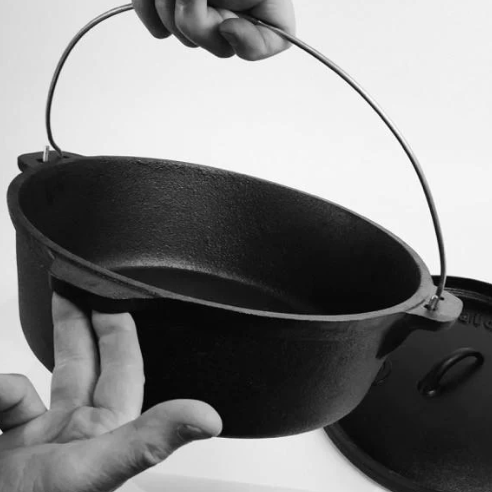
How To Season A New Cast Iron Dutch Oven For The First Time
Dutch ovens are a perennial favorite for several reasons. They're great heat conductors, and the durable construction from solid cast iron lasts for years to come. It's safe to say they're cherished heirlooms for camper families. Most cast iron dutch oven set today arrive pre-seasoned, with standards of pre-seasoning varying from manufacturer to manufacturer or brand to brand.
However, a little TLC from time to time will have them looking good as new and ready for mouthwatering Dutch oven recipes amidst the mesmerizing outdoors. Here's a quick guide for seasoning cast-iron Dutch ovens to prolong their life. But first, what does it mean to season Dutch ovens? Let's find out.
Dutch Oven Seasoning: All You Need to Know
Seasoning Dutch ovens refers to the process of adhering oil to prevent rust, protect the cast-iron material, and create a non-stick surface. Seasoning is important, even before the first use, as it helps remove any residual contaminants from the factory.
Without the additional layer, the Dutch oven will remain exposed to water, oxygen, and vapor, all of which are a perfect recipe for rust spots. With continued use, the coating of your Dutch oven will become reinforced, helping make the cooking process better each time. Thus, for a seamless cooking experience, every time you go camping with your loved ones, make sure to season the Dutch oven once it arrives.
How to Season or Re-Season Cast-Iron Dutch Ovens?

The surface of your Dutch oven is likely to improve over time when you cook food with oil. However, sometimes the coating can rust, deteriorate, or lose its non-stick qualities. Acidic ingredients are quite harsh on cast iron.
If your Dutch oven is rusty, you might need to strip it completely with special cleaners before beginning the seasoning process all over. If it's new or in good condition, it'll just need a refresh. You still need to ensure it's free of any leftover baked-on food by scrubbing it thoroughly with hot water. If you need to use soap, make sure it's a mild one. Towel dry it, and then begin your seasoning journey by following the steps below.
Step 1 – Oil Rub
Picking out the right oil for your Dutch oven seasoning is important. Once the pan is cooled down and completely dried, rub a few drops of lard or vegetable oil into the pot with a paper towel. If the surface absorbs the oil quickly, add in more until the surface changes color and has a shine to it without any leftover dry areas. The goal is to coat the entire pot with the sides, bottom, top, and handle completely covered in a thin layer of oil. However, make sure to wipe out any excess because any extra oil lingering on the pot can make it sticky during and after the heating process. Your pan should look nearly dry once you've completed this step.
Step 2 – Bake
Once you've covered the pot in oil, place the cast-iron Dutch oven upside down on your oven's middle rack and turn the heat on to 400F. Make sure you keep an aluminum foil sheet on the bottom rack to catch possible drips. Bake your pot for up to an hour.
Step 3 – Cool
Let the pot cool down once you turn the oven off but close the oven door. Be patient because this could take a while. Remove the pot once it has completely cooled off. You'll need to repeat the steps a couple of times until your Dutch oven become non-stick and glossy.
Pro Tip: Regularly seasoning your cast iron will keep it free from rust and in great shape for years to come. However, you should avoid storing them in cabinets or places with high moisture levels. We suggest getting a proper tool bag for the cast iron accessories and Dutch Oven Tools Set. It makes it safe, easier to store, and convenient to carry whenever you feel like setting out for a camping trip.
Everyone who cooks with cast-iron Dutch ovens on their camping trips grows to love and cherish the versatile outdoor cooking equipment. Seasoning is just part of the process, but it could easily become a fun activity once you're familiar with its unique charm.
Once your Dutch oven is revitalized, it will soon be ready for creative breakfast, lunch, dinner, snacks, and dessert recipes. Check out our range of cast-iron accessories such as charcoal holders, collapsible charcoal chimneys, kickstands, heat-resistant gloves, portable charcoal grills, lid lifters, and more. You can also order separate Dutch ovens or complete Dutch oven sets to make things easier on your next camping trip.
Reach out to place an order! Follow us on Instagram, Facebook, or YouTube channel to learn more about using CampMaid equipment or staying updated about our innovative outdoor cooking solutions.
Also in News
Dutch ovens are a perennial favorite for several reasons. They're great heat conductors, and the durable construction from solid cast iron lasts for years to come. It's safe to say they're cherished heirlooms for camper families. Most cast iron dutch oven set today arrive pre-seasoned, with standards of pre-seasoning varying from manufacturer to manufacturer or brand to brand.
However, a little TLC from time to time will have them looking good as new and ready for mouthwatering Dutch oven recipes amidst the mesmerizing outdoors. Here's a quick guide for seasoning cast-iron Dutch ovens to prolong their life. But first, what does it mean to season Dutch ovens? Let's find out.
Dutch Oven Seasoning: All You Need to Know
Seasoning Dutch ovens refers to the process of adhering oil to prevent rust, protect the cast-iron material, and create a non-stick surface. Seasoning is important, even before the first use, as it helps remove any residual contaminants from the factory.
Without the additional layer, the Dutch oven will remain exposed to water, oxygen, and vapor, all of which are a perfect recipe for rust spots. With continued use, the coating of your Dutch oven will become reinforced, helping make the cooking process better each time. Thus, for a seamless cooking experience, every time you go camping with your loved ones, make sure to season the Dutch oven once it arrives.
How to Season or Re-Season Cast-Iron Dutch Ovens?

The surface of your Dutch oven is likely to improve over time when you cook food with oil. However, sometimes the coating can rust, deteriorate, or lose its non-stick qualities. Acidic ingredients are quite harsh on cast iron.
If your Dutch oven is rusty, you might need to strip it completely with special cleaners before beginning the seasoning process all over. If it's new or in good condition, it'll just need a refresh. You still need to ensure it's free of any leftover baked-on food by scrubbing it thoroughly with hot water. If you need to use soap, make sure it's a mild one. Towel dry it, and then begin your seasoning journey by following the steps below.
Step 1 – Oil Rub
Picking out the right oil for your Dutch oven seasoning is important. Once the pan is cooled down and completely dried, rub a few drops of lard or vegetable oil into the pot with a paper towel. If the surface absorbs the oil quickly, add in more until the surface changes color and has a shine to it without any leftover dry areas. The goal is to coat the entire pot with the sides, bottom, top, and handle completely covered in a thin layer of oil. However, make sure to wipe out any excess because any extra oil lingering on the pot can make it sticky during and after the heating process. Your pan should look nearly dry once you've completed this step.
Step 2 – Bake
Once you've covered the pot in oil, place the cast-iron Dutch oven upside down on your oven's middle rack and turn the heat on to 400F. Make sure you keep an aluminum foil sheet on the bottom rack to catch possible drips. Bake your pot for up to an hour.
Step 3 – Cool
Let the pot cool down once you turn the oven off but close the oven door. Be patient because this could take a while. Remove the pot once it has completely cooled off. You'll need to repeat the steps a couple of times until your Dutch oven become non-stick and glossy.
Pro Tip: Regularly seasoning your cast iron will keep it free from rust and in great shape for years to come. However, you should avoid storing them in cabinets or places with high moisture levels. We suggest getting a proper tool bag for the cast iron accessories and Dutch Oven Tools Set. It makes it safe, easier to store, and convenient to carry whenever you feel like setting out for a camping trip.
Everyone who cooks with cast-iron Dutch ovens on their camping trips grows to love and cherish the versatile outdoor cooking equipment. Seasoning is just part of the process, but it could easily become a fun activity once you're familiar with its unique charm.
Once your Dutch oven is revitalized, it will soon be ready for creative breakfast, lunch, dinner, snacks, and dessert recipes. Check out our range of cast-iron accessories such as charcoal holders, collapsible charcoal chimneys, kickstands, heat-resistant gloves, portable charcoal grills, lid lifters, and more. You can also order separate Dutch ovens or complete Dutch oven sets to make things easier on your next camping trip.
Reach out to place an order! Follow us on Instagram, Facebook, or YouTube channel to learn more about using CampMaid equipment or staying updated about our innovative outdoor cooking solutions.

4 Sustainable Camping Gear Essentials
Are you a camping enthusiast? Here are four sustainable camping gear essentials that you should consider investing in.
Dutch ovens are a perennial favorite for several reasons. They're great heat conductors, and the durable construction from solid cast iron lasts for years to come. It's safe to say they're cherished heirlooms for camper families. Most cast iron dutch oven set today arrive pre-seasoned, with standards of pre-seasoning varying from manufacturer to manufacturer or brand to brand.
However, a little TLC from time to time will have them looking good as new and ready for mouthwatering Dutch oven recipes amidst the mesmerizing outdoors. Here's a quick guide for seasoning cast-iron Dutch ovens to prolong their life. But first, what does it mean to season Dutch ovens? Let's find out.
Dutch Oven Seasoning: All You Need to Know
Seasoning Dutch ovens refers to the process of adhering oil to prevent rust, protect the cast-iron material, and create a non-stick surface. Seasoning is important, even before the first use, as it helps remove any residual contaminants from the factory.
Without the additional layer, the Dutch oven will remain exposed to water, oxygen, and vapor, all of which are a perfect recipe for rust spots. With continued use, the coating of your Dutch oven will become reinforced, helping make the cooking process better each time. Thus, for a seamless cooking experience, every time you go camping with your loved ones, make sure to season the Dutch oven once it arrives.
How to Season or Re-Season Cast-Iron Dutch Ovens?

The surface of your Dutch oven is likely to improve over time when you cook food with oil. However, sometimes the coating can rust, deteriorate, or lose its non-stick qualities. Acidic ingredients are quite harsh on cast iron.
If your Dutch oven is rusty, you might need to strip it completely with special cleaners before beginning the seasoning process all over. If it's new or in good condition, it'll just need a refresh. You still need to ensure it's free of any leftover baked-on food by scrubbing it thoroughly with hot water. If you need to use soap, make sure it's a mild one. Towel dry it, and then begin your seasoning journey by following the steps below.
Step 1 – Oil Rub
Picking out the right oil for your Dutch oven seasoning is important. Once the pan is cooled down and completely dried, rub a few drops of lard or vegetable oil into the pot with a paper towel. If the surface absorbs the oil quickly, add in more until the surface changes color and has a shine to it without any leftover dry areas. The goal is to coat the entire pot with the sides, bottom, top, and handle completely covered in a thin layer of oil. However, make sure to wipe out any excess because any extra oil lingering on the pot can make it sticky during and after the heating process. Your pan should look nearly dry once you've completed this step.
Step 2 – Bake
Once you've covered the pot in oil, place the cast-iron Dutch oven upside down on your oven's middle rack and turn the heat on to 400F. Make sure you keep an aluminum foil sheet on the bottom rack to catch possible drips. Bake your pot for up to an hour.
Step 3 – Cool
Let the pot cool down once you turn the oven off but close the oven door. Be patient because this could take a while. Remove the pot once it has completely cooled off. You'll need to repeat the steps a couple of times until your Dutch oven become non-stick and glossy.
Pro Tip: Regularly seasoning your cast iron will keep it free from rust and in great shape for years to come. However, you should avoid storing them in cabinets or places with high moisture levels. We suggest getting a proper tool bag for the cast iron accessories and Dutch Oven Tools Set. It makes it safe, easier to store, and convenient to carry whenever you feel like setting out for a camping trip.
Everyone who cooks with cast-iron Dutch ovens on their camping trips grows to love and cherish the versatile outdoor cooking equipment. Seasoning is just part of the process, but it could easily become a fun activity once you're familiar with its unique charm.
Once your Dutch oven is revitalized, it will soon be ready for creative breakfast, lunch, dinner, snacks, and dessert recipes. Check out our range of cast-iron accessories such as charcoal holders, collapsible charcoal chimneys, kickstands, heat-resistant gloves, portable charcoal grills, lid lifters, and more. You can also order separate Dutch ovens or complete Dutch oven sets to make things easier on your next camping trip.
Reach out to place an order! Follow us on Instagram, Facebook, or YouTube channel to learn more about using CampMaid equipment or staying updated about our innovative outdoor cooking solutions.

Choose the Best Dutch Oven: 3 Features to Consider
Are you looking for the best Dutch oven sets online? Here are three features that you should consider when buying one.
Dutch ovens are a perennial favorite for several reasons. They're great heat conductors, and the durable construction from solid cast iron lasts for years to come. It's safe to say they're cherished heirlooms for camper families. Most cast iron dutch oven set today arrive pre-seasoned, with standards of pre-seasoning varying from manufacturer to manufacturer or brand to brand.
However, a little TLC from time to time will have them looking good as new and ready for mouthwatering Dutch oven recipes amidst the mesmerizing outdoors. Here's a quick guide for seasoning cast-iron Dutch ovens to prolong their life. But first, what does it mean to season Dutch ovens? Let's find out.
Dutch Oven Seasoning: All You Need to Know
Seasoning Dutch ovens refers to the process of adhering oil to prevent rust, protect the cast-iron material, and create a non-stick surface. Seasoning is important, even before the first use, as it helps remove any residual contaminants from the factory.
Without the additional layer, the Dutch oven will remain exposed to water, oxygen, and vapor, all of which are a perfect recipe for rust spots. With continued use, the coating of your Dutch oven will become reinforced, helping make the cooking process better each time. Thus, for a seamless cooking experience, every time you go camping with your loved ones, make sure to season the Dutch oven once it arrives.
How to Season or Re-Season Cast-Iron Dutch Ovens?

The surface of your Dutch oven is likely to improve over time when you cook food with oil. However, sometimes the coating can rust, deteriorate, or lose its non-stick qualities. Acidic ingredients are quite harsh on cast iron.
If your Dutch oven is rusty, you might need to strip it completely with special cleaners before beginning the seasoning process all over. If it's new or in good condition, it'll just need a refresh. You still need to ensure it's free of any leftover baked-on food by scrubbing it thoroughly with hot water. If you need to use soap, make sure it's a mild one. Towel dry it, and then begin your seasoning journey by following the steps below.
Step 1 – Oil Rub
Picking out the right oil for your Dutch oven seasoning is important. Once the pan is cooled down and completely dried, rub a few drops of lard or vegetable oil into the pot with a paper towel. If the surface absorbs the oil quickly, add in more until the surface changes color and has a shine to it without any leftover dry areas. The goal is to coat the entire pot with the sides, bottom, top, and handle completely covered in a thin layer of oil. However, make sure to wipe out any excess because any extra oil lingering on the pot can make it sticky during and after the heating process. Your pan should look nearly dry once you've completed this step.
Step 2 – Bake
Once you've covered the pot in oil, place the cast-iron Dutch oven upside down on your oven's middle rack and turn the heat on to 400F. Make sure you keep an aluminum foil sheet on the bottom rack to catch possible drips. Bake your pot for up to an hour.
Step 3 – Cool
Let the pot cool down once you turn the oven off but close the oven door. Be patient because this could take a while. Remove the pot once it has completely cooled off. You'll need to repeat the steps a couple of times until your Dutch oven become non-stick and glossy.
Pro Tip: Regularly seasoning your cast iron will keep it free from rust and in great shape for years to come. However, you should avoid storing them in cabinets or places with high moisture levels. We suggest getting a proper tool bag for the cast iron accessories and Dutch Oven Tools Set. It makes it safe, easier to store, and convenient to carry whenever you feel like setting out for a camping trip.
Everyone who cooks with cast-iron Dutch ovens on their camping trips grows to love and cherish the versatile outdoor cooking equipment. Seasoning is just part of the process, but it could easily become a fun activity once you're familiar with its unique charm.
Once your Dutch oven is revitalized, it will soon be ready for creative breakfast, lunch, dinner, snacks, and dessert recipes. Check out our range of cast-iron accessories such as charcoal holders, collapsible charcoal chimneys, kickstands, heat-resistant gloves, portable charcoal grills, lid lifters, and more. You can also order separate Dutch ovens or complete Dutch oven sets to make things easier on your next camping trip.
Reach out to place an order! Follow us on Instagram, Facebook, or YouTube channel to learn more about using CampMaid equipment or staying updated about our innovative outdoor cooking solutions.

How to Cook with a Dutch Oven while Camping
Are you taking CampMaid’s Dutch oven on your next camping trip? Here’s how you can cook on it.
